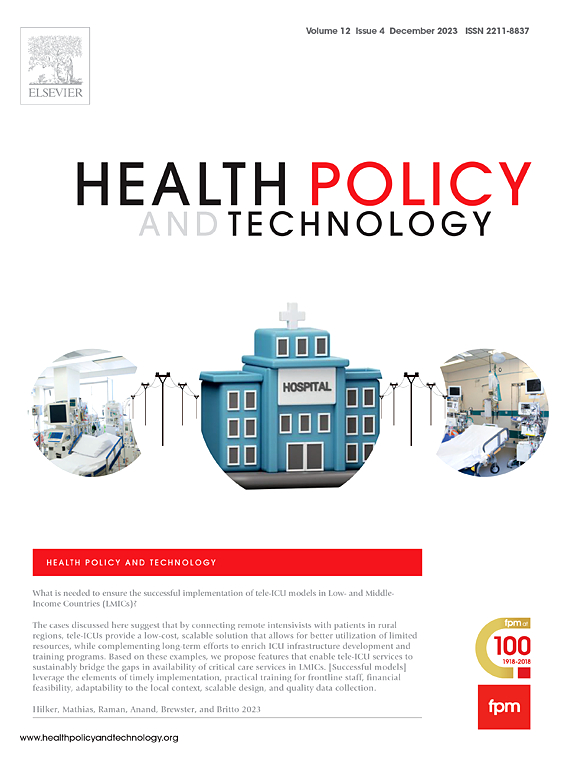关于孟加拉人自我药疗的知识、态度和意识的横断面研究
IF 3.7
3区 医学
Q1 HEALTH POLICY & SERVICES
引用次数: 0
摘要
背景:自我用药是指消费者在没有医生处方的情况下使用药品。自我药疗实践(SMP)被孟加拉国等发展中国家的普通民众广泛采用。方法采用横断面研究。主要数据是通过在线调查收集的。数据收集于2021年4月至2021年9月进行。受试者年龄至少为15岁。来自孟加拉国35个地区,共有322名不同年龄、教育水平和经济阶层的人参与了调查。结果71%(229人)的调查对象年龄在21 ~ 25岁之间。66%为本科生。他们大多来自中产阶级,受过良好的教育。80%的人说他们没有处方就购买或服用了药物。其中57%的人说他们不认为自我药疗是一种非常安全的做法,尽管87%的人在前一年至少进行过一次自我药疗。退烧药(212)、镇痛药(165)、感冒药/止咳药(197)和抗溃疡/抗酸药(140)是自我用药的主要类别。几乎全部(311人)从药店领取SMP药品。以前的处方(146人)、家人或朋友的建议(165人)和互联网或其他媒体(113人)是他们自我用药实践的常见信息来源。结论自我药疗在孟加拉国非常普遍。人们对它可能带来的负面后果没有足够的认识。因此,应该更严格地执行有关药品买卖的监管法律。由于一些社会经济和生活方式因素,包括随时获得药物,通过自我保健管理某些疾病的可能性增加,以及药品的可获得性增加,孟加拉国的自我药疗实践率似乎正在增加。自我药疗不仅在孟加拉国很普遍,而且以灾难性的速度出现。本文显示了人们对SMP和其他健康问题的总体认识水平,人们通常购买哪些药物及其信息来源。本文章由计算机程序翻译,如有差异,请以英文原文为准。
A cross-sectional study regarding the knowledge, attitude and awareness about self-medication among Bangladeshi people
Background
Self-medication is the use of medicinal products by the consumer which is not prescribed by a doctor. Self-medication practice (SMP) is widely adopted by the common people of developing countries like Bangladesh.
Methods
It was a cross-sectional study. Primary data were collected by conducting an online survey. Data collection was carried out from April 2021 to September 2021. The subjects were a minimum of 15 years of age. From 35 districts of Bangladesh, a total of 322 people of different age groups, education levels, and economic classes participated in the survey.
Result
71% (229) of the respondents were 21-25 years of age. 66% were undergraduate students. Most of them were from middle class society and well-educated. 80% of the population said that they had purchased or taken medicines without any prescription. 57% of them said they do not consider self-medication a very safe practice although, 87% of the population had practiced self-medication at least once in the preceding year. Antipyretics (212), Analgesics (165), Drugs for Cold/Cough (197) and Anti-ulcer/Antacids (140) were the majority categories of medicines that were used mostly for self-medication. Nearly all (311) of them collect SMP medicine from pharmacy shops. Previous prescriptions (146), advice from family or friends (165) and Internet or other media (113) were common sources of information for their self-medication practice.
Conclusion
Self-medication practice is highly prevalent in Bangladesh. People are not aware enough about the possible negative outcomes of it. Therefore, regulatory laws should be implemented more strictly regarding buying and selling medicines.
Lay Summary
The rate of self-medication practice appears to be increasing in Bangladesh, due to a number of socioeconomic and lifestyle factors that include ready access to drugs, increased potential to manage certain illnesses through self- care, and greater availability of medicinal products. Self-medication is not only prevalent in Bangladesh, it is present at a catastrophic rate. This article shows the overall awareness level of people regarding SMP and other health issues, which medicines are commonly being bought by people and their sources of information.
求助全文
通过发布文献求助,成功后即可免费获取论文全文。
去求助
来源期刊

Health Policy and Technology
Medicine-Health Policy
CiteScore
9.20
自引率
3.30%
发文量
78
审稿时长
88 days
期刊介绍:
Health Policy and Technology (HPT), is the official journal of the Fellowship of Postgraduate Medicine (FPM), a cross-disciplinary journal, which focuses on past, present and future health policy and the role of technology in clinical and non-clinical national and international health environments.
HPT provides a further excellent way for the FPM to continue to make important national and international contributions to development of policy and practice within medicine and related disciplines. The aim of HPT is to publish relevant, timely and accessible articles and commentaries to support policy-makers, health professionals, health technology providers, patient groups and academia interested in health policy and technology.
Topics covered by HPT will include:
- Health technology, including drug discovery, diagnostics, medicines, devices, therapeutic delivery and eHealth systems
- Cross-national comparisons on health policy using evidence-based approaches
- National studies on health policy to determine the outcomes of technology-driven initiatives
- Cross-border eHealth including health tourism
- The digital divide in mobility, access and affordability of healthcare
- Health technology assessment (HTA) methods and tools for evaluating the effectiveness of clinical and non-clinical health technologies
- Health and eHealth indicators and benchmarks (measure/metrics) for understanding the adoption and diffusion of health technologies
- Health and eHealth models and frameworks to support policy-makers and other stakeholders in decision-making
- Stakeholder engagement with health technologies (clinical and patient/citizen buy-in)
- Regulation and health economics
 求助内容:
求助内容: 应助结果提醒方式:
应助结果提醒方式:


